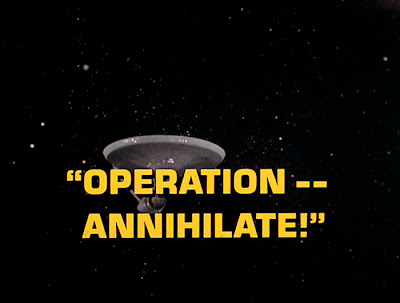"The Apple"
Kirk and crew beam down to Gamma Trianguli VI, encountering exploding rocks and killer plants before meeting the natives, who call themselves "The Feeders of Vaal." It turns out Vaal is a computer which sustains itself by using the food given it by the people. Vaal has trapped the Enterprise in a tractor beam and is pulling it down to the planet, and Kirk is forced to intervene. He orders Scotty to blast the computer with the Enterprise's phasers, destroying it. The people of GT VI are now free to live without the machinations of Vaal, but Spock wonders if Kirk's actions were not unlike those of a certain serpent entering a well-known garden and spreading chaos.
Story
"The Apple" has a story that is not new to sci-fi nor to Trek. At this point in the series, we've already seen the controlling computer as enemy twice, in "The Return of the Archons" and "A Taste of Armageddon." "Archons" was extremely weak, whereas "Armageddon" succeeded in using the "master computer" scenario to great effect. Thus, "The Apple" is a waste of an episode that really has very little to offer. One wonders why this episode was made.
Action
There's plenty of action in "The Apple," from exploding rocks and killer plants to phaser barrages on unsuspecting computer deities to lethal lightning strikes. Yet none of it saves the episode from being lackluster and downright odd.
Trektastic Moments
I have to talk about a few moments in "The Apple" that are at least interesting in terms of this year-long odyssey. Not one but FOUR Redshirts buy it in this episode, and I have to think that this was the episode that gave birth to the Redshirt tradition. The first Redshirt is poisoned and killed by a lethal plant, the second is blown to bits by an exploding rock, the third is reduced to a smoldering pile of ash by a lightning bolt, and the fourth is bludgeoned with a large tree branch by a Feeder. It's downright funny to watch these poor bastards get wiped out, and unlike the first crew deaths in the early part of the series, we just can't sympathize with Kirk's sorrow over losing these guys. I laughed out loud each time one of the Reddies bit the dust, and I know that wasn't the intent.
There's also the fact that the writer of this episode must have thought Spock was from Krypton, not Vulcan. Spock gets shot by the killer plant, blasted by Vaal's forcefield, and a jolt from lightning, leading to second-degree burns. The man gets tossed around like a sock puppet. Or would be a "Spock puppet." This was the strangest treatment of Spock's alien nature in the series.
We also have Kirk's dilemma with The Prime Directive. On one hand, he could have asked the Feeders what they wanted, but on the other hand, he had to save his ship. In my opinion, Kirk was left with no other choice than to destroy Vaal, if only to save the Enterprise and the four hundred plus crew aboard her. But he maybe should have asked the Feeders if they would want to be free before ordering the firing to start.
Overall
"The Apple" is weak but has some amusing Redshirt deaths and a few one liners from Spock and Kirk. Outside of that, it's a miss. C-
The episode's title card.

Redshirt #1 gets the point.

Reshirt #2 gets a charge.

Redshirt #3 is blown away. Trust me, that's pieces of him. Somewhere.

Redshirt #4 gets ahead.

































